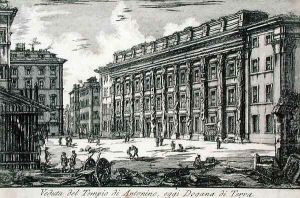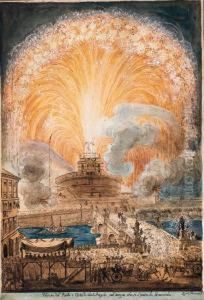(attr.to) Piranesi, Laura Paintings
Giovanni Battista (also spelled Giambattista) Piranesi was an Italian artist famous for his etchings of Rome and of fictitious and atmospheric 'prisons' (Carceri d'Invenzione). Born in Mogliano Veneto, near Treviso, then part of the Republic of Venice, on October 4, 1720, Piranesi was an important figure in the European art world of the 18th century. His father was a stonemason, and his mother was a niece of the Venetian master printer, Alvisopoli. Piranesi received his early education in Venice, showing a talent for drawing and architecture.
In his early 20s, Piranesi went to Rome, which became his adopted home and the main subject of his art. He studied etching with Giuseppe Vasi and became deeply interested in the architecture of ancient Rome, including its ruins, which he began to document with obsessive precision. His works were not just simple representations; they were often imaginative reconstitutions or capricci, where reality and fantasy blended. He produced a series of prints in 1745 titled 'Prima Parte di Architetture e Prospettive' (First Part of Architecture and Perspectives), followed by the famous 'Carceri' series, which depicted enormous and fantastical prisons with Kafkaesque sequences of staircases and mighty machines.
Piranesi's most famous works, however, are the 'Vedute di Roma' (Views of Rome), a series of over 135 large-scale etchings that offer a comprehensive view of the ancient and modern ruins of Rome and its surroundings. They were sold to tourists and became so popular that they were an essential part of the Grand Tour. These prints were celebrated for their technical prowess, their imaginative reconstruction of Roman architecture, and their influence on contemporary and future tastes in neoclassical architecture.
Throughout his career, Piranesi was also an architect, though few of his designs were ever built. He was an avid collector of Roman antiquities and opened a workshop for the restoration of antiquities, where his etchings served as a catalog for potential buyers. His influence extended beyond art and into the fields of history and archaeology; his detailed renderings of Roman engineering and his polemics in debates over the relative merits of Roman versus Greek architecture were groundbreaking at the time.
Giovanni Battista Piranesi died in Rome on November 9, 1778. His legacy endures through his etchings, which continue to be admired for their artistry and technical skill. They have inspired countless artists, architects, filmmakers, and writers and remain a primary source for the study of Roman architecture. Piranesi's work also contributed significantly to the development of neoclassicism in the late 18th century and to the romanticized vision of ancient Rome that prevailed in European culture for many years.

